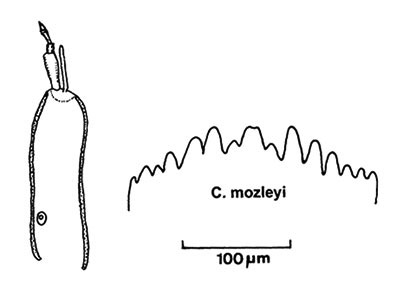Species 3u. C. mozleyi Wülker, 2007.Originally C. species Michigan A - Wülker, Devai and Devai (1989) Adult:
The adults of this species are not known for sure, but adults reared from fluviatilis-larvae in the area are similar to those of C. decorus-group species. Pupa – not known. Fourth instar larva of fluviatilis-type, i.e. ventral tubules scimitar shaped with relatively pointed ends. Length 5.4–15.9 mm (presumably the very small specimens are third or early fourth instar); no lateral tubules. Ventral tubules longer than width of abdominal segments, posterior pair longer. Anal tubules well developed, sometimes constricted at midpoint. Head capsule of normal width, with gula sometimes slightly darkened, frontoclypeus pale.
Mentum (below) with central trifid tooth tall, c1 and c2 teeth moderately separated (type III), with the fourth laterals about as high as the fifth laterals (type II); relative height of sixth lateral unclear from figure.
About 30 (29-31) striae on each ventromental plate. Antenna (below) with basal segment 120 (115-127) µm about 2.5-2.9 times longer than wide (41-47 µm), Ring organ about a third of the way up from base of the segment; AR 2.1-2.3; A2 length 24 (27-32) µm., 0.25 of A1 length
Mandible about 300 (285-315) µm long, with all inner teeth darkened (Type IIIB). 
Antenna and mentum of C. mozleyi, from Wálker (2007)Cytology: 4 polytene chromosomes with the thummi arm combination: AB, CD, EF, G.
Arm G with a nucleolus at one end and a contriction near the other. Distal of the constriction, and also near the middle of the arm, are two BRs. Sometimes a puff is developed in arm B. Polymorphic for arms A, B, C, D, E, and F.
moz A1: 1a-e, 10-12, 3if-, 15a-e, 3e-2d, 9e-a, 7-4, 8g-a, 14-13, 2c-1f, 16-19
moz A2: 1a-e, 8a-g, 4-7, 9a-e, 2d-3e, 15e-a, 3f-i, 12-10, 14-13, 2c-1f, 16-19
moz B1: Obvious dark bands at distal end.
moz B2+3: Differs from B1 by an included inversion, such that dark bands are now proximal, but median section of arm is in same order as in B1
moz C1: approx. 1-2c, 17a-16, 6b-5c, 8-11c, 15-13, 5b-2d, 7d-6c, 17b-22
moz C2: approx. 1-2c, 17a-16, abt. 14-15, 11c-8, 5c-6b, abt. 13f-a, 5b-2d, 7d-6c, 17b-22
moz D1: approx. 1-3, 11-12, 15-13d, 4(?)-8,13c-a(?), 16(?), 9-10, 17-24
moz D2: approx. 1-3. 11-12, 23a-17, 10-9, 16(?), 13a-c(?), 8-4(?), 13d-15, 23b-24
moz E1: 1 - 3e, 5 - 10b, 4 - 3f, 10c - 13; i.e. as aberratus, bifE1, etc.
moz E2: 1 - 3e, 5 - 6, 12c - 10c, 3f - 4, 10b - 7, 12d - 13
moz F1: 1a-i, 9-5d, 16-17, 10a-d, 13b-11, 13cd, 18-19b, 2-5c, 15-14, 19c-23
moz F2: 1a-i, 9-5d, 16-17, 10a-d, 13b-12, 19dc, 14-15, 5c-2, 19b-18, 13dc, 11a-i, 20-23 Found: Michigan - Lake Michigan (Type locality).From depths of 12-15 m in fine sand sediments.Larva is most easily distinguished from the co-habiting C. winnelli by the wider head capsule, the mentum type, and the higher number of striae on the ventromentum. This species is a member of the C. decorus-group. Sequences for arms A, E and F given in Wülker, Devai and Devai (1989) as C. sp. Michigan A. Description of the species by Wülker (2007). Holotype in Zoologische Staats Sammlung, Munich. See also C. winnelli, C. bifurcatus, C.sp. b, C. sp. c, C. sp. j, C. sp. 2a, C. sp. 2b, C. 'butleri', C. sp. 3h, C. sp. 3i, C. sp. 3j, C. harpi, C. blaylocki, C. decorus Johannsen. [ Return to Index| Go to References ] |
